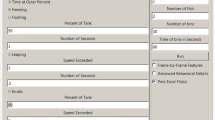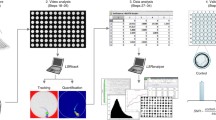A new algorithm for long-term continuous computer recording and analysis of motor activity of a group of zebrafish in the home tank has been developed. The movements of a group of Danio rerio during the entire light period and for several days are recorded at a frequency of 1 frame/sec in the form of short (15 min) files. Then these files are analyzed by the unique DanioStudo software, which, using a threshold algorithm and appropriate masks, calculates for each frame the sum of pixels associated with fish (the sum of fish silhouettes), and for two consecutive frames, the sum of altered pixels (the sum of altered fish silhouettes). The following indexes are calculated: the rate of sum of silhouettes alteration as the ratio of the sum of altered silhouettes to the sum of silhouettes (1) and the time spent in the selected area of the home tank as the ratio of the sum of silhouettes in this area to the sum of silhouettes in the entire tank (2). The mean rate of silhouette alteration correlates to the length of the path travelled by the fish and, therefore, serves as a correct measure of the motor activity of a group of fish. Using these algorithms, completely new data were obtained: it was shown that the motor activity of fish remains constant throughout the entire light period, but depends on the size of the home tank. The proposed approach, together with the DanioStudio software, can be effective in studying the dynamics of changes in the behavior of fish under long-term exposure to short daylight, drugs and toxic substances.
Similar content being viewed by others
References
Kalueff AV, Stewart AM, Gerlai R. Zebrafish as an emerging model for studying complex brain disorders. Trends Pharmacol. Sci. 2014;35(2):63-75. doi: https://doi.org/10.1016/j.tips.2013.12.002
Stewart AM, Braubach O, Spitsbergen J, Gerlai R, Kalueff AV. Zebrafish models for translational neuroscience research: from tank to bedside. Trends Neurosci. 2014;37(5):264-278. doi: https://doi.org/10.1016/j.tins.2014.02.011
Kulikov AV, Sinyakova NA, Kulikova EA, Khomenko TM, Salakhutdinov NF, Kulikov VA, Volcho KP. Effects of acute and chronic treatment of novel psychotropic drug, 8-(trifluoromethyl)-1, 2, 3, 4, 5-benzopentathiepin-6-amine hydrochloride (TC-2153), on the behavior of zebrafish (Danio Rerio): a comparison with fluoxetine. Lett. Drug Design Discov. 2019;16(12):1321-1328. doi: https://doi.org/10.2174/1570180816666190221162952
Kulikov AV, Morozova MV, Kulikov VA, Kirichuk VS, Popova NK. Automated analysis of antidepressants’ effect in the forced swim test. J. Neurosci. Methods. 2010;191(1):26-31. doi: https://doi.org/10.1016/j.jneumeth.2010.06.002
Steinskog DJ, Tjøstheim DB, Kvamstø NG. A cautionary note on the use of the Kolmogorov—Smirnov test for normality. Monthly Weather Rev. 2007;135(3):1151-1157. doi: https://doi.org/10.1175/MWR3326.1
Dreosti E, Lopes G, Kampff AR, Wilson SW. Development of social behavior in young zebrafish. Front. Neural Circuits. 2015;9:39. doi: https://doi.org/10.3389/fncir.2015.00039
Tang W, Davidson JD, Zhang G, Conen KE, Fang J, Serluca F, Li J, Xiong X, Coble M, Tsai T, Molind G, Fawcett CH, Sanchez E, Zhu P, Couzin ID, Fishman MC. Genetic control of collective behavior in zebrafish. iScience. 2020;23(3):100942. doi: https://doi.org/10.1016/j.isci.2020.100942
Harpaz R, Aspiras AC, Chambule S, Tseng S, Bind MA, Engert F, Fishman MC, Bahl A. Collective behavior emerges from genetically controlled simple behavioral motifs in zebrafish. Sci. Adv. 2021;7(41):eabi7460. doi: https://doi.org/10.1126/sciadv.abi7460
Kulikov AV, Tikhonova MA, Kulikov VA. Automated measurement of spatial preference in the open field test with transmitted lighting. J. Neurosci. Methods. 2008;170(2):345-351. doi: https://doi.org/10.1016/j.jneumeth.2008.01.024
Author information
Authors and Affiliations
Corresponding author
Additional information
Translated from Byulleten’ Eksperimental’noi Biologii i Meditsiny, Vol. 175, No. 1, pp. 122-127, January, 2023
Rights and permissions
Springer Nature or its licensor (e.g. a society or other partner) holds exclusive rights to this article under a publishing agreement with the author(s) or other rightsholder(s); author self-archiving of the accepted manuscript version of this article is solely governed by the terms of such publishing agreement and applicable law.
About this article
Cite this article
Kulikov, P.A., Sorokin, I.E., Evsiukova, V.S. et al. Long-Term Continuous Computer Registration and Analysis of Motor Activity of a Group of Zebrafish Danio rerio. Bull Exp Biol Med 175, 106–111 (2023). https://doi.org/10.1007/s10517-023-05820-3
Received:
Published:
Issue Date:
DOI: https://doi.org/10.1007/s10517-023-05820-3




